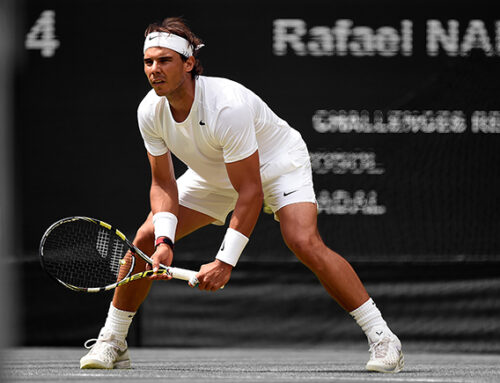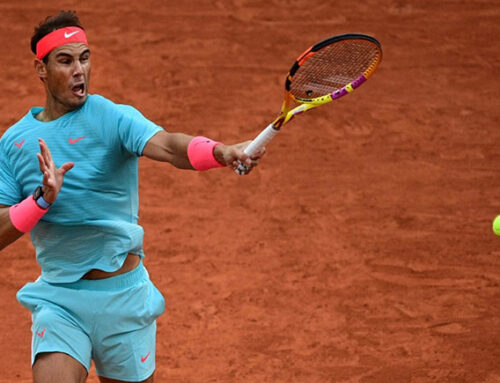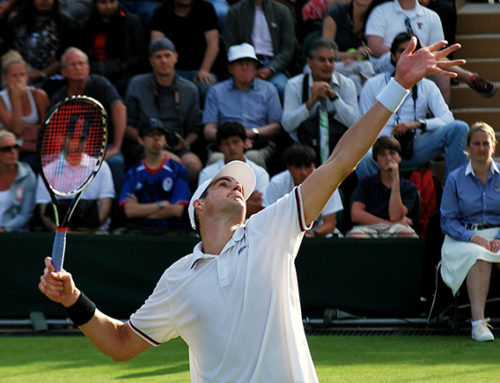This is the first in a three-part series on serve and volley tennis in the modern game.On September 21st, 2007 Tim Henman defeated Roko Karanusic in straight sets to give Great Britain a 2-0 lead in their Davis Cup tie against Croatia. Although he would team with Jamie Murray to seal the victory in doubles the next day, his victory marked Tim Henman’s last official singles match on the men’s tour. It also marked the last true serve and volleyer at the top of the game. In the 5 years since, we have seen some aggressive players (Tsonga immediately leaps to mind), they are more all-court players, roaming forward occasionally when they see a tactical advantage in doing so. However, they more likely to stay back than not. Even the great Roger Federer – the last man to win Wimbledon serve and volleying nearly every point – uses it sparingly.So where did all the serve and volleyers go?
To begin with, let’s contrast the net approaches of a real serve and volley player versus an aggressive all-court player. In his first round win at the US Open this year, Tsonga came to the net 27 times in 3 sets. In beating Donald Young in straight sets, Federer came in 23 times. In a 4 set loss to Almagro, Radek Stepanek came in only 36 times. That’s roughly 9 times per set.
Playing Andre Agassi in the 4th round in 2007, Patrick Rafter came to the net 152 times in 4 sets. That’s almost 40 times a set. It’s an astounding difference, and barely scratches the surface of the difference between a genuine serve and volleyer and a modern day attacking player. Let’s take a look at the number of serve and volleyers in the top 10 over the last 25 years:
1990: 4
1994: 5
1999: 3
2004: 1
2011: 0
If you look at each and every year, you will see the decline begins in earnest at the turn of the century. Then in the space of 5 short years, the serve and volley game goes from a place of prominence to virtually non-existent. At present on the tour, the highest-ranked genuine serve and volleyer is Michael Llodra all the way down at 52.
So why have the net rushers become extinct? What happened?
Equipment
This is only a part of the equation and perhaps the one that gets blamed the most. Yes, equipment has changed and it can take some of the ‘blame’. But it isn’t racket technology as much as it is string technology. The advent of monofilaments like Luxilon have given players the ability to get more spin than ever on the ball, making it possible to hit returns that have both pace and spin. As a serve and volleyer, handling a fast ball is fine. Handling a dipping ball can be tough but is fine. Handling a ball that does both is brutal. However this takes the lion’s share of the blame unfairly. The same strings are available to players on both sides of the net. If the returner can get more spin on the ball, so too can the server. In theory he should be able to make the ball go faster, higher, move more and reach more of the box than his compatriots from 20 years ago!
Technique
Players these days have superior groundstroke technique compared to 20 years ago (or even 10 years ago). Off their groundstrokes players are now able to generate more spin and speed, even without better strings than the old guard used. However if we look at the technique of serves and volleys, not much has changed. A good backhand volley looks amazingly like it did 25 years ago. Raonic’s serve, while excellent, is in form similar to that of Richard Krajicek or Mark Philippoussis. So we have advancements in groundstroke technique (returns and passing shots) without real advancement in serve and volley technique. This is going to obviously cause a shift in the balance.
Adaptation
I’ve always considered there to be two types of serve and volleyers. In the first, you had the players like Henman, Rafter and Edberg – guys with ‘tricky’ serves and amazing volleys. Then you had guys like Ivanisevic and Rusedski – guys with huge serves and mediocre volleys. Sampras is in a weird spot in this spectrum because he had a better serve than the second group, but to my judgment not quite as good of a volley skillset as the first group. So here’s where the theory of adaptation comes in…
I remember the first time I ever played someone who had a legitimate 130 mph serve. I was still a junior, playing in Australia in the mid 90’s. I played a guy who had been in the Australian Open Junior tournament that year, and had clocked the fastest serve in the tournament outside of the Open Men’s (and faster than most of the Open Men’s too for that matter). Now granted I played some pretty high level junior tennis, but 16 years just didn’t serve that big back then. I stepped up to return serve the first time believing, in my cocky youth, that I could handle it.
WHAM.
The ball literally seemed to come to me in stages. I saw it hit the strings. Next time I saw the ball it was roughly at the net. The next time I saw the ball it was a couple of feet away. Then it was gone. This was no movie clip, oh no. It was a slideshow of me getting aced. That’s how my brain processed it. I got some back in play, here and there. But I felt so harried, so… fortune each time.
Fast forward 15 years. I’m playing a league doubles match against a former professional player who also had a legitimate 130 mph serve. In two sets I didn’t miss a single return on his serve. Not one. What a difference time can make! But in reality it wasn’t because my reflexes were measurably faster at 33 or 34 than they were as a 16 year old. The difference is in the interim, I have seen many big servers. Where as in my junior days 130 mph serves were a genuine rarity, they became more and more commonplace.
Around 1990, there were a handful of “big” servers in the world – guys who could step onto a tennis court and count on the majority of their first serves not getting back in play. At this year’s US Open, the *slowest* server in the quarter-finals dropped some 126 mph bombs. You can find random guys in the first round – people you’ve never even heard of – topping 130 mph on a regular basis. And the thing of it is, human beings adapt – it’s what we do best. Show me enough 130 mph serves, and I will figure out a way to get them back. And if I need to, I’ll figure out a way to get them back well enough to win.
It’s all about exposure. 20 years ago there was a handful of guys in the world who could serve like that. If you wanted to get practice returning a serve like that for real, you either had to face one of them in the draw or be lucky enough to get on a practice court with them. Now? There’s a 20% chance your local teaching pro is a former player (college or pro) who can do it. It isn’t *special* anymore.
Immaturity
This might take a second to explain, but I’ll get there. The professional tennis tour is a cold and unforgiving place. If you are trying to make it as a pro, the margins are amazingly slim. It isn’t enough to be good. It isn’t enough to have two or three legitimate weapons. There is 1000 guys out there who have that now. You need luck, you need funding, you need opportunity.
The typical serve and volleyer matures later than his baseline-hugging compatriot. If we throw out outliers like Becker and Sampras (both of whom came onto the tour with amazingly big serves at a time when they were truly uncommon), most serve and volleyers hit their peak late in their careers. Rafter and Henman are classic examples – both really coming into their own in their mid to late 20s. This is not by chance – it happens with good reason.
When we look at the way human beings master skills, there are two basic elements – exposure and repetition. You need to be exposed to the environment in which the skill will be practiced, and then you need a significant number of repetitions of the skill in that environment. You may have heard of the “10,000 hour rule”. It applies to tennis as much as it does to anything else. If we take this idea that it requires 10,000 hours of practicing a skill to become genuinely world-class at it it becomes easy to quickly see why serve and volleyers mature later than baseliners.
In a typical rally between baseliners, the ball will be struck 10-15 times. In a typical serve and volley point, it will be struck 2-5 times. We accept that the majority of the time spent on the court when we play a match isn’t spent actually in the point. It’s spent getting the balls, toweling off, walking back to position, engaging in the pre-serve routine… For a serve and volley player, the ball is actually in play a fraction of the time that it is for a baseliner. In the same number of points played, a serve and volley player will hit 1/2 to 1/3 the number of shots, and spent 1/2 to 1/3 the amount of time ‘in the point’. This means they get less meaningful practice.
Sure, they can drill. Any player worth their salt does. But drilling is only preparation for playing – it is no substitute. All of this adds up to a genuine serve and volley player taking years longer to mature than a baseline player. When we come back to my initial comment in this section on the unforgiving nature of the professional tour, you might begin to see the problem.When you’re out playing Futures of Challenger events, you’re basically losing money in order to play ‘professionally’. The amount that you win offsets these losses and extends your ability to stay out on tour for longer hoping for a breakthrough. If you play a style of game that naturally tends to mature later, then it’s going to take you more tournaments, more years, more matches to peak and realistically get your big chance.
So is the serve and volley game officially dead? I don’t believe so. I believe it is possible to be a successful serve and volleyer on the professional tour today. However I also believe that it will take a complex set of scenarios to make it happen. And that’s what I’ll talk about in Part 2!


